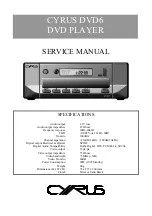
MD-R3H
– 15 –
Button operation in CD test mode
1. [STOP]
: Specific operation is stopped, resulting in TEST mode waiting state. The pickup slide
is kept in stop state.
2. [ ]
: The pickup slides toward the external periphery.
3. [ ]
: The pickup slides toward the internal periphery.
When the switch (Pu_IN) is on, the slide is stopped.
4. [DISP]
: When this switch is pressed in TEST 4 or later, it is accepted, and the mode is changed
directly to TEST 3.
(Tracking servo OFF)
6.Hold down [CD-PLAY] for 500 msec
: This button is accepted in the TEST waiting state, and mode is changed directly to
TEST 5.
Caution
1.Even when the sub-code cannot be read during playing, the [STOP] button must be accepted to perform the STOP operation.
2.When the [CD-EJECT] button is pressed, the tray must be opened after normal STOP operation.
2. Adjusting the servo unit
Set all the half-fixed resistors in the mechanical center position.
Set the CD test mode 0, and shift the pickup to the center.
Set the CD test mode 1. (Make sure that laser lights.)
After loading the disc set the test mode 2.
(Make sure that the focus servo is on. The disc does not rotate but mechanical tone is heard.)
Set the CD test mode 3. (The spin servo is turned on, and the disc turns.)
Tracking error balance adjustment
VR751
*1 (Figure 16-1)
Pin 6 (1/2Vcc) and pin 4 (TG1) of TP751
Set the CD test mode 4. (Tracking servo ON)
Tracking gain adjustment
VR752
Get the same waveform on
Pin 4 (TG1), pin 2 (TG2) and pin 6 (1/2Vcc)
CH1 and CH2. *2
of TP751 (Relay circuit is used)
Set the test mode 5, and make sure that track No. and time are indicated.
Apply a black tape to the disc, and play back this part. (Figure 16-2). (It is allowed to apply any mode in addition to test mode.)
Focus offset adjustment
VR753
*3
Pin 6 (1/2Vcc) and pin 1 (FG1) of TP751 *4
Tracking offset adjustment
VR754
*5
Pin 6 (1/2Vcc) and pin 4 (TG1) of TP751 *6
Adjustment classification
Connection of measuring instrument
Setting/adjusting procedure
*1: Taking 1/2Vcc as a reference DC level, make an adjustment to get vertical symmetry of waveform (Figure 16-1) with respect
to the reference DC level.
(Amplitude 0.5 to 1.5 Vp-p) (As the optical pickup has been adjusted before shipping, adjustment is required only when
adjustment disturbance is found.)
*2: Input oscillation frequency 1.5 kHz, 300 mVrms
*3: Make an adjustment so that the error waveform is minimized (Figure 16-3), noise (track jump sound) ceases during audio output
monitoring and clear playback is ensured.
*4: The proper measurement range of oscilloscope is 50 mV, 0.5 ms.
Connect the trigger to the pin 39 (HFD) of IC750, apply coupling on DC (-) slope, and observe waveform in the normal trigger
mode.
*5: Make an adjustment so that the error waveform becomes uniform and is minimized (Figure 16-3), noise (track jump sound)
ceases during audio output monitoring, clear playback is ensured and sound skip and pause state do not occur.
*6: The proper measurement range of oscilloscope is 0.1V, 0.5 ms. The trigger is the same as stated in the note*4 above.
Reference: If the error waveform contains significant noise and is not clear, observe the waveform, using the low-pass filter (Figure
16-4).
Adjusting object
















































